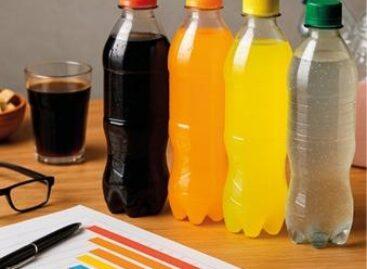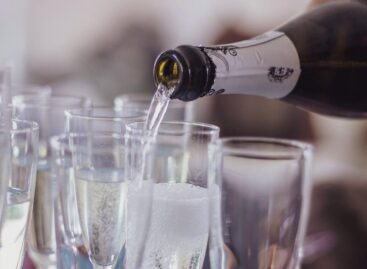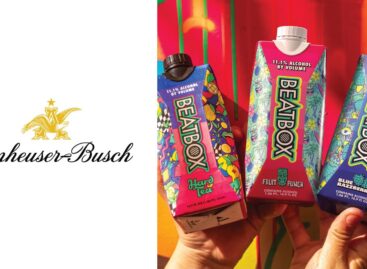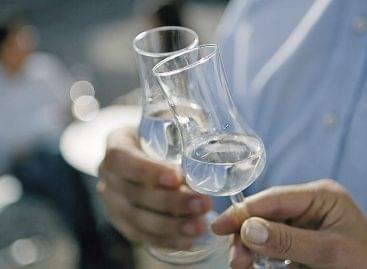Bravery, dynamism and quality – Cocktail, No&Low, RTD
International trends in cocktail making are now reaching premium bars and nightclubs in Hungary sooner than a decade ago, when a few-year delay was general.
This article is available for reading in Trade magazin 2024/4
The pandemic and the subsequent inflationary crisis have changed alcohol consumption habits around the world, and surprisingly many of the new behaviours we saw then have persisted. The needs and desires of Generation Z are changing the world of mixed drinks in many ways, for instance they are influenced by health trends and moderate consumption. Experts say this new attitude contributes to the success of craft beers, RTDs, and innovative cocktails that didn’t exist before.
What do Hungarian experts think?
Ádám Kamarás, brand ambassador of Dunapro:

Ádám Kamarás
brand ambassador
Dunapro
“Three Hungarian bars have been included in the Discovery List of ‘The World’s 50 Best’, which is selected by international experts, but there are also other bars that would be a success in any European city”.
On the other hand, the sector as a whole is still lagging behind the major international trends in certain respects, which can be observed from both the professional and consumer sides. More and more bars have drink lists featuring exciting, home-made ingredients, and visual appeal is also becoming increasingly important.

Many countries with advanced drinks culture hold events linked to a particular cocktail, such as Negroni or Martini week

Zsolt Stork
national HoReCa manager
Zwack Unicum
“Despite the decline in the HoReCa segment, sales of premium products have remained stable, with only a small drop in certain categories. The super-premium category is still on the rise, and the clear loser in on-trade sales is the low price category, but we aren’t present there”,
says Zsolt Stork, Zwack Unicum’s national HoReCa manager.

Attila Piri
marketing director
Heinemann
“In the past 2 years several HoReCa units have closed for good, not only because of the increase in energy costs but also because of changing consumer habits. Based on the experience of our wholesale partners, I can say that sales revenues dropped in the HoReCa channel. Nevertheless, HoReCa remains a priority for us”,
points out Attila Piri, marketing director of Heinemann.
Trendy in 2024
– The minimalist approach is gaining ground, the quality of the ingredients is what matters the most, and cocktails with just three ingredients are making a comeback.
– This year classic cocktails are predicted to experience a renaissance – a return to basics instead of using advanced techniques, but made with ingredients of the highest quality.
– It is time for bars to create their own unmistakable drink, a signature cocktail.
– Agave-based drinks, which have become incredibly popular in recent years, are also conquering the cocktail scene.
– Espresso Martini is now one of the top 10 most popular cocktail types in the world, ushering in a new era of coffee-based cocktails.
– “Fat washing” is an old technique from perfumery: an oily or fatty substance is soaked in alcohol, the liquid is frozen and the fat that rises to the surface is removed, but the flavour extracted by the alcohol remains in the liquid. This is how cocktails such as sesame oil gin, bacon fat whisky or peanut butter-infused aged rum are made.

In many ways, we are now at the top of the world: at the WCC 2023 World Cocktail Championships in Rome, Hungary’s team came first out of 67 nations
Common sense
Generation Z also plays a key role in the development of the low-alcohol and no-alcohol (No&Low) drinks segment. According to IWSR data, the non-alcoholic spirits category expanded by 8% in 2022 and is expected to continue to grow at a CAGR of 7% between 2022 and 2027. Experts are wondering where the limits to the development of these products lie, i.e. how many people and for how long will want to drink without getting “dizzy”. A non-alcoholic cocktail may be attractive to those who want to stay out late with friends but wish to keep alcohol consumption to a minimum. There are No&Low versions of many spirit brands on the market, but more often these are launched under new brand names.
No&Low is more of a playground for HoReCa in Hungary
Ádám Kamarás reckons that there is a noticeable increase in interest in the No&Low category in Hungary too, but it is still a long way from the point where these products will be widely available in bars. Still, many of the top cocktail bars in Hungary are already serving drinks made from non-alcoholic spirits. He believes there is a bigger demand for premium alternatives in the HoReCa sector for non-alcoholic offerings than in retail. From a bartender’s point of view, No&Low spirits are great to pair with mixers or other ingredients, but it is important to get the proportions right.
According to Attila Piri, non-alcoholic spirits finally reached Hungary in 2023. All the top bars have non-alcoholic spirits in their portfolios. Recognising the opportunity, some of the big producers have already started to make 0% products. Their conquest in both HoReCa and retail is going to be a longer process, but interest has already been expressed by retail buyers.
Zsolt Stork thinks the popularity of the No&Low category is steadily growing worldwide – including Hungary. People are looking for healthier alternatives to alcoholic drinks, and many are curious about the non-alcoholic versions of these.

Bence Kardos
bar manager
GoodSpirit Bar
“Today guests are looking for a taste experience in their drinks, even if they choose non-alcoholic alternatives. The rise in popularity of non-alcoholic cocktails indicates that No&Low spirits have their place in the market and should be watched in the coming years”, says Bence Kardos, bar manager of GoodSpirit Bar.
What is RTD?
RTD is the fastest growing category in the drinks world, but the concept and indeed the term itself isn’t familiar to Hungarian consumers. These beverages fall into the RTD category according to the IWSR:
– Cocktails in RTS (ready to serve) form, containing more than 10% alcohol;
– Known cocktail types and long drinks containing a base spirit and a non-alcoholic element, in which the base alcohol is clearly identifiable;
– Other flavoured alcoholic beverages, e.g Bacardi Breeze, Smirnoff Ice;
– Hard seltzers – a mixture of carbonated water and alcohol, sometimes with the addition of fruit flavour – in which the alcohol base isn’t specified;
– Hard teas and coffees: teas and coffees with an unspecified alcohol base;
– Fizzers and coolers: wines mixed with soda or fruit juice.

Cocktail, No&Low, RTD – Pentire’s 2 dl Margarita cocktail fits into all three categories. At $18, what demand would there be for it in Hungary?
A dynamically changing, colourful world
We are talking about an extremely dynamic category, but the stunning growth of RTD sales in 2018-2021 (20% per year in volume terms) slowed down to 2% in 2022. Accordingly, the IWSR halved its 5-year forecast from a year earlier: analysts now predict a growth of just 12% in the category for the 2022-2027 period, representing a CAGR increase of 2%. Anyway, the RTD category is thought to reach a USD 40bn value by 2027, driven by growth in the cocktail, long drink and other premium categories. Consumer research by IWSR has revealed that the influence of a brand on purchasing decisions is declining: in June 2023 US consumers were asked how they choose an RTD product, and 53% of Americans cited flavour, 36% said spirit base, 35% named cocktail type and 31% answered alcohol content, with only 27% citing a well-known brand. Consumers are keen to try new products, which mainly means new flavours, but it isn’t uncommon to experiment with different base versions of the same flavours.

In many American restaurants, the bartender works alongside the dessert chef: dessert cocktails are trendy, which guests eat at the end of the meal with or instead of dessert
Something is starting!
Attila Piri explains that the RTD market is still a small segment, but it is growing and more and more new products are entering the category. Long drink RTDs are the most popular. Heinemann is currently marketing Jim Beam &Cola in 0.33-litre format with 4.6% alcohol.
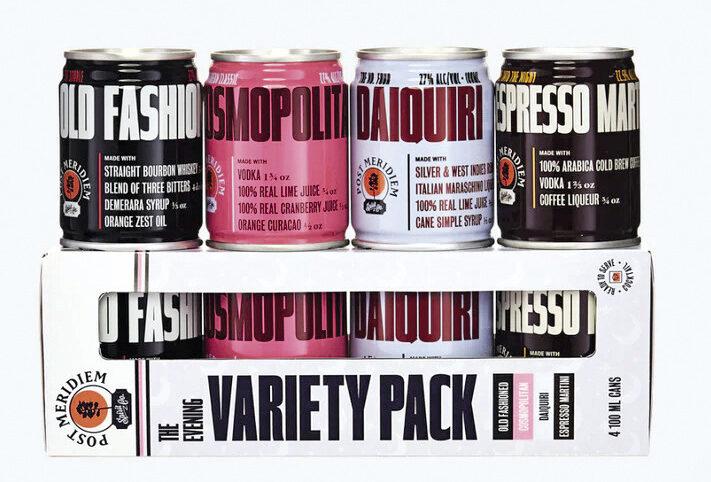
Within the RTD category, ready to serve cocktails with high-alcohol content are also developing rapidly
In Hungary the primary target group for RTD drinks is young people aged 18-29. Csenge Bujdosó, brand manager of Dunapro: “In Hungary the ready-to-drink market is undergoing dynamic changes and the category is already growing, with more and more players and new flavours appearing in the market. Practical packaging, predictable quality, easy consumption and affordable price are some of the reasons behind the rapid growth of the RTD drinks category. Recognising this, DunaPro launched the MIX brand in 2023: 6 types of 4% alcohol, vodka and gin-based drinks made from premium quality ingredients, in 0.33-litre screw-top bottles”. //
Cocktails on tap
It would seem logical that premixed quality cocktails should become part of the trend of serving premixed quality cocktails on tap. Mixed drinks made by the serving are considered to be classic, but if we accept that the 0.7- or 1-litre cocktails available from the big brands in retail outlets are premium products, we should also be able to accept the perfect quality of cocktails on tap.
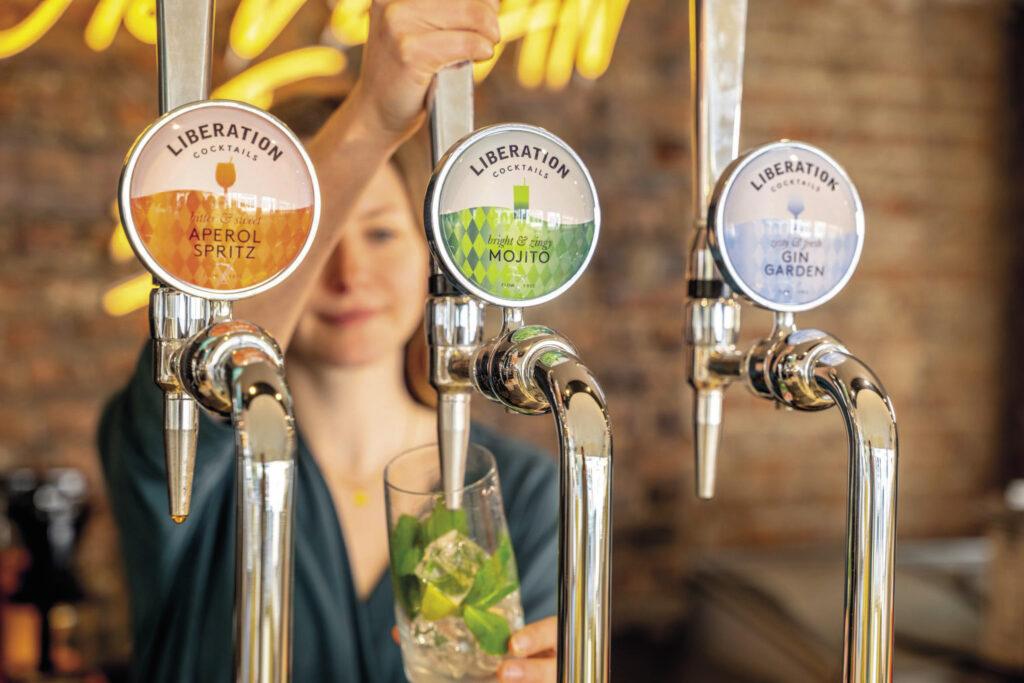
Cocktails on tap can be measured to a tenth of a part even with the fastest service
While cocktail service from the tap requires some improvements to guarantee that the customer receives a perfect, ready-to-drink beverage, it does offer operational efficiency, speed and accuracy. The main advantage of a cocktail on tap is that the end result is exactly the same every time. In a crowded bar stress can be avoided by having “barrel” cocktails ready to serve. Guests expect the same taste from each new batch of drink they order, and a cocktail on tap is a safer way to deliver that than one made from scratch. //
Generation Z and alcohol
According to a March analysis by IWSR, the changing consumption habits of young people could have a noticeable influence on the US alcohol market in the medium term. Generation Z has a different attitude towards alcohol than older generations: they are more reserved and moderate drinkers, like new or newly discovered drink categories such as RTD, and could potentially transform the spirits market in the years to come. Generation Z and Generation Y are driving the growth in No&Low product sales together, as two-thirds of them are cutting their alcohol consumption. Members of Generation Z are happy to experiment with flavours and like to drink something different, e.g. craft beers, RTDs, innovative cocktails. //
Related news
Rapid changes, adaptive path
🎧 Hallgasd a cikket: Lejátszás Szünet Folytatás Leállítás Nyelv: Auto…
Read more >Sparkling wine 2025
🎧 Hallgasd a cikket: Lejátszás Szünet Folytatás Leállítás Nyelv: Auto…
Read more >Anheuser-Busch acquires majority stake in BeatBox for $490M
🎧 Hallgasd a cikket: Lejátszás Szünet Folytatás Leállítás Nyelv: Auto…
Read more >Related news
2026 begins in agriculture amid crises and a wave of investment – banking focuses on the dairy and pig markets, as well as CAP investments
🎧 Hallgasd a cikket: Lejátszás Szünet Folytatás Leállítás Nyelv: Auto…
Read more >Sovereignty Protection Office: According to the public, there is no place for foreign majority ownership in strategic sectors
🎧 Hallgasd a cikket: Lejátszás Szünet Folytatás Leállítás Nyelv: Auto…
Read more >Poor fruit harvest weighs on the pálinka sector
🎧 Hallgasd a cikket: Lejátszás Szünet Folytatás Leállítás Nyelv: Auto…
Read more >

